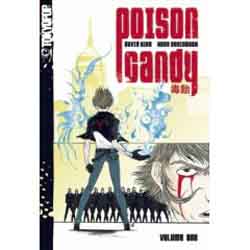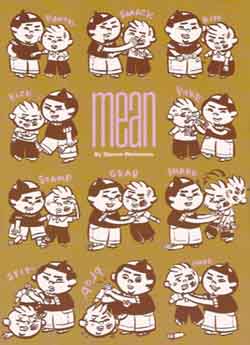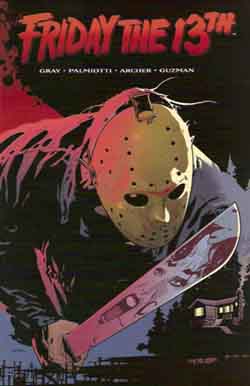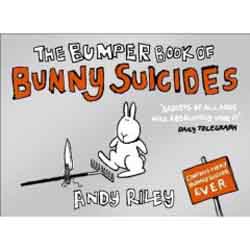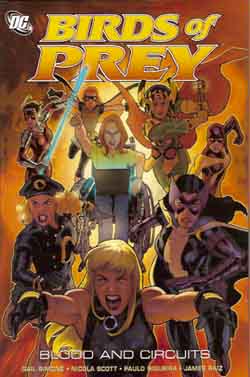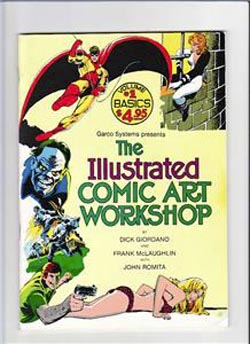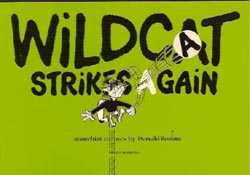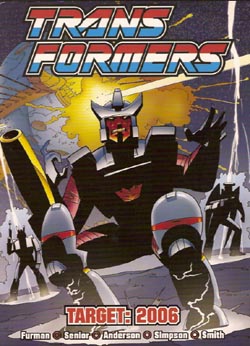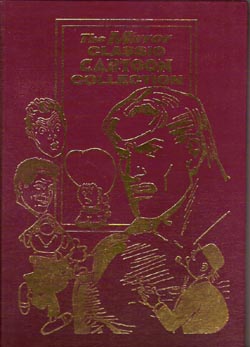
By various, compiled by Mike Higgs (Hawk Books)
ISBN 0-948248-06-8
The Daily Mirror has been home to a number of great strips over its long history – beginning with one of the Empire’s greatest successes Tiger Tim, who debuted there in 1904 and culminating with the likes of the war-winning nymphette Jane, The Perishers, Garth and Andy Capp. The latter two feature in this beautiful compilation from Mike Higgs’ Hawk Books which has done so much over the years to keep British cartoon history alive.
This particular effort collects sample selections from the newspaper’s back catalogue in a spiffy hardback that is stuffed with fun, thrills and quality nostalgia.
Garth is the first star featured in an adventure from 1957 by series originator and longest serving creator Steve Dowling (1943-1969 – succeeded by his assistant John Allard, then Frank Bellamy and finally Martin Asbury). Garth is a hulking physical specimen, a virtual human superman with the involuntary ability to travel through time and experience past and future lives. This simple concept lent the strip an unfailing potential for exotic storylines and fantastic exploits.
‘The Captive’ – written by Peter O’Donnell and illustrated by Dowling and Allard – is a contemporary tale with our hero abducted from Earth as a prize in a galactic scavenger hunt instigated by bored hedonistic aliens who don’t realise quite what they’ve gotten themselves involved with… A second adventure, ‘The Man-hunt’, is the last that Frank Bellamy worked on. The astounding Bellamy died in 1976 whilst drawing this story of beautiful alien predators in search of prime genetic stock with which to reinvigorate their tired bloodlines. Written by Jim Edgar, the strip was completed by Asbury who took over with the 17th instalment. This tongue-in-cheek thriller is full of thrills and fantastic action, yet never loses its light humorous touch.
Andy Capp is a drunken, skiving, misogynistic, work-shy, wife-beating scoundrel who has somehow become one of the most popular and well-loved strip characters of all time. Created by jobbing cartoonist Reg Smythe to appeal to northern readers during a circulation drive, he first saw the light of day – with long-suffering wife Florrie in tow – on August 5th 1957. The volume reprints 37 strips from the feature’s 41 year run, which only ended with Smythe’s death in 1998, but the sheer magic of this lovable rogue is as inexplicably intoxicating as it always was, defeating political correctness and common decency alike: A true Guilty Pleasure.
Romeo Brown began in 1954, drawn by Dutch artist Alfred “Maz†Mazure, and starred a private detective with an eye for the ladies and a nose for trouble. The feature was a light, comedic adventure series that added some glamour to the dour mid-1950s, but really kicked into high gear when Maz left in 1957 to be replaced by Peter O’Donnell and the brilliant Jim Holdaway, who would go on to create the fabulous Modesty Blaise together. The strip ended in 1962 and is represented here by a pair of romps from their penultimate year. ‘The Arabian Knight’ and ‘The Admiral’s Grand-daughter’ combine sly, knowing humour, bungling criminality and dazzlingly visuals in a manner any Carry-On fan would die for.
Useless Eustace was a gag-panel (a single-picture joke) that ran from January 1935 to 1985. Created by Jack Greenall, its star was a bald nondescript everyman who met the travails of life with unflinching enthusiasm but very little sense. Greenall produced the strip until 1974, and other artists continued it until 1985. The selections here are from the war years and the 1960s. Another comedy panel was Calamity Gulch, a particularly British view of the ubiquitous “Western†which invaded our sensibilities with the rise of television ownership in the 1950s. Created by Jack Clayton, it began its spoofing and sharp-shooting on 6th June 1960, and you can see 21 of the best right here, Pardner.
A staple of children’s comics that never really prospered in newspapers was the sports adventure. At least not until 1989 when those grown up tykes opened the Daily Mirror to find a football strip entitled Scorer, written by Barrie Tomlinson and drawn by Barry Mitchell, and eventually John Gillatt. Very much an updated Roy of the Rovers, the strip stars Dave ‘Scorer’ Storry and his team Tolcaster F.C. in fast, hot, sexy tales of the Beautiful Game that owed as much to the sports pages it began on as to the grand cartoon tradition. ‘Cup Cracker’, included here is by Tomlinson and Gillatt from 1994, and shows that WAGS (Wives And GirlfriendS, non-sports fans) were never a new phenomenon.
Not many people know this, but before I review an old book (which I arbitrarily define as something more than three years old) I try to locate copies on the internet. It’s a supreme disappointment then for me to admit that this wonderful and utterly British tome is readily available in France, Germany – most of Europe in fact (and you could order it from Amazon.fr for example), but not in any English-speaking nation that I could find. Perhaps that’s a testament to the book’s quality and desirability, and if that’s the case maybe The Mirror Group should expedite a new edition – or even a few sequels…
© 1998 Mirror Group Newspapers, Ltd. All Rights Reserved.
